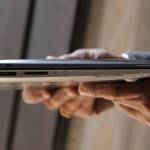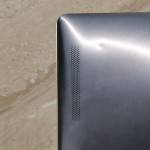Laptops, Notebooks, Netbooks, Desktops, the personal computers have seen a lot of transformation in past decade. Already the terms are pretty confusing with each variant serving a defined purpose. With the advent of tablets, it has become even more difficult to choose amongst them. Tablets are portable, provide better battery life whereas notebooks allow heavier computing operations to be performed, coding, graphics, etc. You might need notebook one day and tablet some other. Convenient it may sound but budget is a spoil sport. So what do you do? You look out for Asus Transformer series. Yes, the name says it all. Asus came up with transformable notebook-cum-tablet wherein you get the best of both worlds.
Courtesy Asus India, I had the opportunity to play with Asus Transformer Book TX300. What follows is Transformer Book TX300 review (no brainer!) and just a small disclaimer, since it isn’t a genre specific hardware, I have skipped the benchmark tests.
Design – Overall Appearance
TX300 has looks to kill. Period. I will try to explain the appearance of the device but you’ve got to see it in person to realize how much effort Asus has put into its design. The transformer book possess an all metal design with a sleek brushed silver aluminium keyboard area complimented by vertical hairline design atop keyboard region and a unique spun grey’ish’ metal finish at the back of the screen.

The screen, which also acts as a tablet once detached has ~20 mm bezel around the main 13.3″ inch display. The numeric value 20 might sound large but in actual usage the bezel isn’t a hindrance rather it prevent unintentional touches. There’s a standard issue backlit keyboard minus the numeric keypad accompanied by couple of manufacture specific buttons. For a 13″ inch notebook, I think taking out number pad is a better design choice rather than cramping in the full blown keyboard and thus smaller keys.
Another impressive design quality is the thickness, the tablet has a thickness of 10.5 mm and dock 12.9 mm. Talking about the tablet, 10.5 mm isn’t record breaking figure but given the fact that it hosts a battery and SSD of it’s own, it’s indeed pretty impressive.
Specifications
Justifying the price tag Transformer Book TX300 carries, it offers numerous connectivity solutions. Starting with the detachable tablet-cum-touch panel there is a MicroSD card slot at the bottom, 3.5 mm audio jack and Micro HDMI port on the left hand side along-with the volume rocker and power button (screen on/off) at the top. There’s also a front HD camera and 5 MP rear shooter (this one is optional though). The keyboard dock hosts regulars like power connector, SD (and SDHC) memory card reader at the left and LAN port, two USB 3.0 ports, Mini Display port at the right.
Inside TX300 there is an Intel Dual-Core i7 3517U Ivybridge processor (sorry, no Haswell) clocked @ 1.9 Ghz to 3 Ghz, 4 GB DDR3 1600 MHz SDRAM, Intel HD4000 on-board graphics processor, Wireless LAN 802.11b/g/n wireless and Bluetooth 4.0. There’s ample of storage available at disposal, 628 GB in total. The interesting thing is, seperate storage has been provided for both the tablet-cum-touch panel and keyboard dock. The touch panel has a Sandisk U100 128 GB SSD whereas the keyboard dock hosts a Hitachi 500 GB HDD.
Display – The Screen Quality
Asus Transformer Book TX300 sports a 13.3″ Full HD IPS panel display. The display size of 1920 x 1080 yields an approximate 165 ppi (pixels per inch) of pixel density. One might argue that the pixel density is relatively low when compared to other competing products in the market (let’s just say Nexus 7), however given the fact that it tries to serve multiple purpose, I think a lower ppi screen isn’t a bad deal at all. Moreover, in daily usage, while viewing photographs, surfing web, watching videos, I couldn’t care less about the ppi specifications. Courtesy IPS panel technology used, the edge-to-edge glass display in itself emits strong and vibrant colors with excellent viewing angles.
Sound Performance
I usually refrain from including sound quality, performance in notebook reviews simply because you are not paying for a music system. You’d rather buy an iPod or invest in some good home theater. Anyhow, the reason we are talking about audio quality is that Transformer Book TX300 is very expensive and the fact that it also serves as a tablet. And thus media playback should be reasonably tolerable if not ear shattering 😉
The TX300 features four speakers developed in collaboration with Bang & Olufsen ICEpower. Couple with their in-house SonicMaster technology, the sound quality is claimed to be “outstanding cinematic”. Now I am not an audiophile to be able to judge the sound quality to precision but from my experience of watching the more recent episode of The Big Bang Theory (Season 7, Episode 15 – The Locomotive Manipulation ), all I can say is Penny sounded as beautiful as she always does and sound of locomotives was crystal clear 🙂
Jokes apart, sound output was acceptable by all means. Using the pre-installed MaxxAudio software, you could tweak the sound to some extend with all those customizable EQ but as it is, I have no qualms with sound output.
Battery Life
As with the treatment of in-built storage capacity, Asus has followed the same path and provided each unit with its own individual, independent battery pack. The tablet-cum-display touch panel has an understandably larger battery power measuring 5000 mAh (2 cells) whereas the keyboard dock has 3120 mAh of power (2 cells).
Since I have been using this ‘transformer’ (sounds fancy, no?!) as a daily driver, I wasn’t able to test the battery time to the critical level. But to give you a fairly good idea, I used it both as a tablet and notebook, as and when required. With screen brightness set to 60%, always connected to Wi-Fi network, tasks like web surfing, music playback in background, 20-30 minutes of video streaming and some php coding, the notebook lasted for approximately 6.5 hours. A more judicious use and aggressive power management practices can boost up this time.
One subtle feature I’d like to share is the use of magnetic power connection for charging Transformer Book TX300. It’s not a great feature to brag about but certainly useful if you into the habit of tripping over wires in your house or at work place. A magnetic power connection means that the wire dislodge instead of bringing down your notebook to the floor.
Windows 8 Experience
Asus Transformer Book TX300 comes pre-installed with Windows 8. The way people perceive Windows 8 as a touch OS is beyond the scope of this review. However speaking strictly from the point of view of using Windows 8 on this device, I’d say except for minor bumps here and there, the touch and OS both did very well. I have been using Windows 8.1 on my Dell Inspiron 15R and have started to like it but with a touch interface, the metro interface gets even more useful! With Window 8.1 update 1 slated for launch somewhere around March, the minor bugs will be ironed out.

And regardless of what others say, it’s just not right to compare Windows 8 with Android or iOS, the former is a mature full blown operating system whereas android, iOS are more of handled devices. With Widows 8 on tablet, you can expect to perform all the tasks that you normally perform on a notebook, laptop or desktop.
Concluding Words
The Asus Transformer Book TX300 is a real charmer with beautiful design, sturdy build quality and great specifications. It transforms into a tablet and a notebook at the snap of a finger minus the hassle. You have a tablet for casual web surfing, video watching or game playing and a notebook for heavy duty work, as and when you need it. It is practical and usable. This being said, the price tag of Rs. 91,999 isn’t justified especially when talking in context of a market like India where premium products have a limited market space.

































